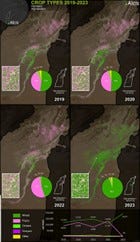Opium v. wheat production in Helmand, Afghanistan (2019 – 2023)
Health issues, food security and global systems
A few weeks ago, the Conservative MP Tobias Ellwood got into hot water over a comment he made regarding the role of the Taliban in the control of heroin from the poppy fields of Afghanistan. Here are some interesting facts and maps.
[Teachers – the data here would make a good data response question…. Analyse the changes over the period shown.]
The cultivation of opium in Afghanistan dropped by over 95% between 2022 and 2023. This resulted in a collective loss of income for Afghan farmers of an estimated $1 billion. The UN’s Office for Drugs and Crime have attributed this fall to the Taliban’s policies against drug use since taking over the country since 2021. The Taliban have sought to eradicate Afghanistan’s dependency on the drug industry.
The disruption to the cultivation of poppies has affected the livelihoods of farmers and agricultural labourers in the country. The poppy is grown mostly in the south of the country, and the acreage devoted to its production fell from over 220,000 hectares (ha) to 10,000 ha. Consequently, the supply of opium decreased from over 6,000 tonnes in 2022 to just over 300 tonnes the following year. Much of the land has been converted to wheat farming, aiming to improve food supplies. Wheat is not as lucrative for Afghan farmers.
Until this year, Afghanistan was the centre of the world’s production of heroin. This is now not the case. It will be interesting to see the impact on economic livelihoods, political stability, and migration within and from the country.
These images are from: Alcis - Copyright @ Alcis 2023 | Basemap copyright @ Esri.
You can download them from:




